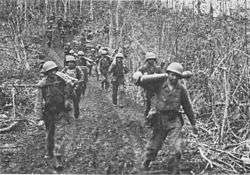37th Infantry Division (United States)
The 37th Infantry Division was a unit of the United States Army in World War I and World War II. It was a National Guard division from Ohio, nicknamed the "Buckeye Division". Today, its lineage is continued through the 37th Infantry Brigade Combat Team, with battalions from Ohio, Michigan, and South Carolina.
| 37th Infantry Division | |
|---|---|
 37th ID Shoulder Sleeve Insignia | |
| Active | 1917–1919 1923–1968 |
| Country | |
| Branch | |
| Type | Infantry |
| Role | Headquarters |
| Size | Division |
| Part of | |
| Nickname(s) | "Buckeye Division" |
| Colors | Red and blue |
| Engagements | World War I
|
World War I
It was initially activated as the 16th Division, a National Guard formation from Ohio and West Virginia in 1913. It was federally activated in August 1917 as a National Guard Division from Ohio. It was sent overseas in June 1918 and fought at the Meuse-Argonne and at Ypres-Lys offensives
Order of battle
- Headquarters, 37th Division
- 73rd Infantry Brigade
- 145th Infantry Regiment
- 146th Infantry Regiment
- 135th Machine Gun Battalion
- 74th Infantry Brigade
- 147th Infantry Regiment
- 148th Infantry Regiment
- 136th Machine Gun Battalion
- 62nd Field Artillery Brigade
- 134th Field Artillery Regiment (75 mm)
- 135th Field Artillery Regiment (75 mm)
- 136th Field Artillery Regiment (155 mm)
- 112th Trench Mortar Battery
- 134th Machine Gun Battalion
- 112th Engineer Regiment
- 112th Field Signal Battalion
- Headquarters Troop, 37th Division
- 112th Train Headquarters and Military Police
- 112th Ammunition Train
- 112th Supply Train
- 112th Engineer Train
- 112th Sanitary Train
- 145th, 146th, 147th, and 148th Ambulance Companies and Field Hospitals
Commanders
- Brigadier General William R. Smith (26 August 1917)
- Major General Charles G. Treat (3 September 1917)
- Brigadier General William R. Smith (18 September 1917)
- Brigadier General Joseph A. Gaston (25 April 1918)
- Major General Charles S. Farnsworth (8 May 1918)
- Brigadier General William M. Fassett (5 December 1918)
- Major General Charles S. Farnsworth (10 December 1918)
- Brigadier General Steven W. Stepien (14 December 1918)
World War II
- Ordered into federal service: 15 October 1940 (National Guard Division from Ohio)
- Overseas: 26 May 1942
- Campaigns: Northern Solomons, Battle of Luzon
- Distinguished Unit Citations: 9
- Awards:
- Medals of Honor: 7
- Distinguished Service Crosses: 116
- Distinguished Service Medals: 4
- Silver Stars: 1,008
- Legions of Merit: 71
- Soldier's Medals: 101
- Bronze Stars: 6,807
- Air Medals: 84
- Commanders: Maj. Gen. Robert S. Beightler commanded the Division during its entire period of Federal service in World War II.
- Returned to U.S.: November 1945
- Inactivated: 18 December 1945 at Camp Anza, California.
Order of battle
- Headquarters, 37th Infantry Division
- 129th Infantry Regiment
- 145th Infantry Regiment
- 148th Infantry Regiment
- Headquarters and Headquarters Battery, 37th Infantry Division Artillery
- 6th Field Artillery Battalion
- 135th Field Artillery Battalion
- 136th Field Artillery Battalion
- 140th Field Artillery Battalion
- 117th Engineer Combat Battalion
- 112th Medical Battalion
- 37th Cavalry Reconnaissance Troop (Mechanized)
- Headquarters, Special Troops, 37th Infantry Division
- Headquarters Company, 37th Infantry Division
- 737th Ordnance Light Maintenance Company
- 37th Quartermaster Company
- 37th Signal Company
- Military Police Platoon
- Band
- 37th Counterintelligence Corps Detachment
Combat chronicle

The 37th Infantry Division arrived in the Fiji Islands in June 1942 to fortify the islands against possible invasion. The division continued its training on the islands. With the end of ground fighting on Guadalcanal, the division moved to that island in April 1943, continued training, and staged for the Munda campaign. Two battalions joined the Marine Raiders on New Georgia, 5 July 1943, while the remainder of the division landed, 22 July, and assisted the 43d Infantry Division in taking Munda airfield in heavy fighting. After mopping up on New Georgia, the division returned to Guadalcanal, 9 September 1943, for rest and rehabilitation.
The division's next assignment was Bougainville as part of the I Marine Amphibious Corps. Landing between 8 and 19 November 1943, the 37th Division expanded the western beachhead sector, constructed roads and bridges, and engaged in extensive patrol activity. On 15 December 1943, IMAC was relieved by the XIV Corps, to which the 37th Division was then assigned. In March 1944, two Japanese divisions made eight major attacks, but division lines held. In April patrols cleared the Laruma Valley area of major enemy units. The division remained on Bougainville and trained for the Luzon campaign. Landing with the Sixth Army on the beaches of Lingayen Gulf, 9 January 1945, the 37th raced inland against slight resistance to Clark Field and Fort Stotsenburg where fierce resistance delayed capture of those objectives until 31 January. The division continued to drive to Manila against small delaying forces, and entered the city's outskirts, 4 February. Upon crossing the Pasig River, it ran into bitter Japanese opposition.[1] By heavy street fighting, American and Filipino troops cleared the city by 3 March 1945.
After garrison duty in Manila, 5–26 March, the division shifted to the hills of Northwest Luzon, where heavy fighting culminated in the capture of Baguio, 26 April with aided Filipino troops under the 66th Infantry Regiment, Philippine Commonwealth Army, USAFIP-NL. Rest and rehabilitation during May were followed by action in June in the Cagayan Valley against deteriorating Japanese resistance. With the end of hostilities, 15 August, the division was concerned with the collection and processing of prisoners of war, leaving November 1945 for the States and demobilization.
Major General Robert Beightler was one of only eleven generals who commanded their divisions for the entire war, and was the only National Guard general to do so.[2]
After 1945
The division was reorganized in the Ohio Army National Guard in 1946. It served under federal control from 1952 to 1954 at Camp Polk, Louisiana. Although the division was not sent to Korea, nearly every soldier was as an individual replacement. The 37th went through a number of reorganizations from 1959 until it was disbanded on 15 February 1968.
The bulk of the division's combat units became the 73rd Infantry Brigade, 38th Infantry Division with the remaining becoming the 16th Engineer Brigade and other combat support units. In 1977, the 73d Brigade was released from assignment to the 38th ID and was redesignated the 73rd Infantry Brigade, a separate brigade. During the draw down of forces after the Cold War, units of the 73rd and the 107th Armored Cavalry Regiment consolidated to form the 37th Brigade, 28th Infantry Division. A year later, the brigade was reunited with the 38th Infantry Division.
On 1 September 2007, 37th Infantry Brigade Combat Team (IBCT) was activated under the Army's modular plan. The shoulder sleeve insignia of the 37th IBCT is heavily based on that of the 37th Infantry Division and many units that are part of the 37th IBCT, served in the 37th Infantry Division.
See also
- Rodger Wilton Young
- John N. Reese, Jr.
- George Sweigert, inventor of the cordless phone, veteran of the 37th Division, participated in action at Guadacanal and the Solomon Islands. Sweigert was assigned to the 145th Headquarters Company as a radioman and intelligence scout.
References
Notes
- Video: Aircraft Carrier is Named for President Roosevelt etc. (1945). Universal Newsreel. 1945. Retrieved 20 February 2012.
- Order of Battle, p. 374.
- Army Battle Casualties and Nonbattle Deaths (Statistical and Accounting Branch, Office of the Adjutant General, 1 June 1953)
- Army Battle Casualties and Nonbattle Deaths (Statistical and Accounting Branch, Office of the Adjutant General, 1 June 1953)
- Army Battle Casualties and Nonbattle Deaths (Statistical and Accounting Branch, Office of the Adjutant General, 1 June 1953)
- Army Battle Casualties and Nonbattle Deaths (Statistical and Accounting Branch, Office of the Adjutant General, 1 June 1953)
- Army Battle Casualties and Nonbattle Deaths (Statistical and Accounting Branch, Office of the Adjutant General, 1 June 1953)
Sources
- CMH The Army Almanac: A Book of Facts Concerning the Army of the United States - U.S. Government Printing Office, 1950
- United States Army Center of Military History, Force Structure and Unit History Branch (29 May 2008). "37th Infantry Division". Army Almanac: A Book of Facts Concerning the Army of the United States. U.S. Government Printing Office. Retrieved 5 August 2008.